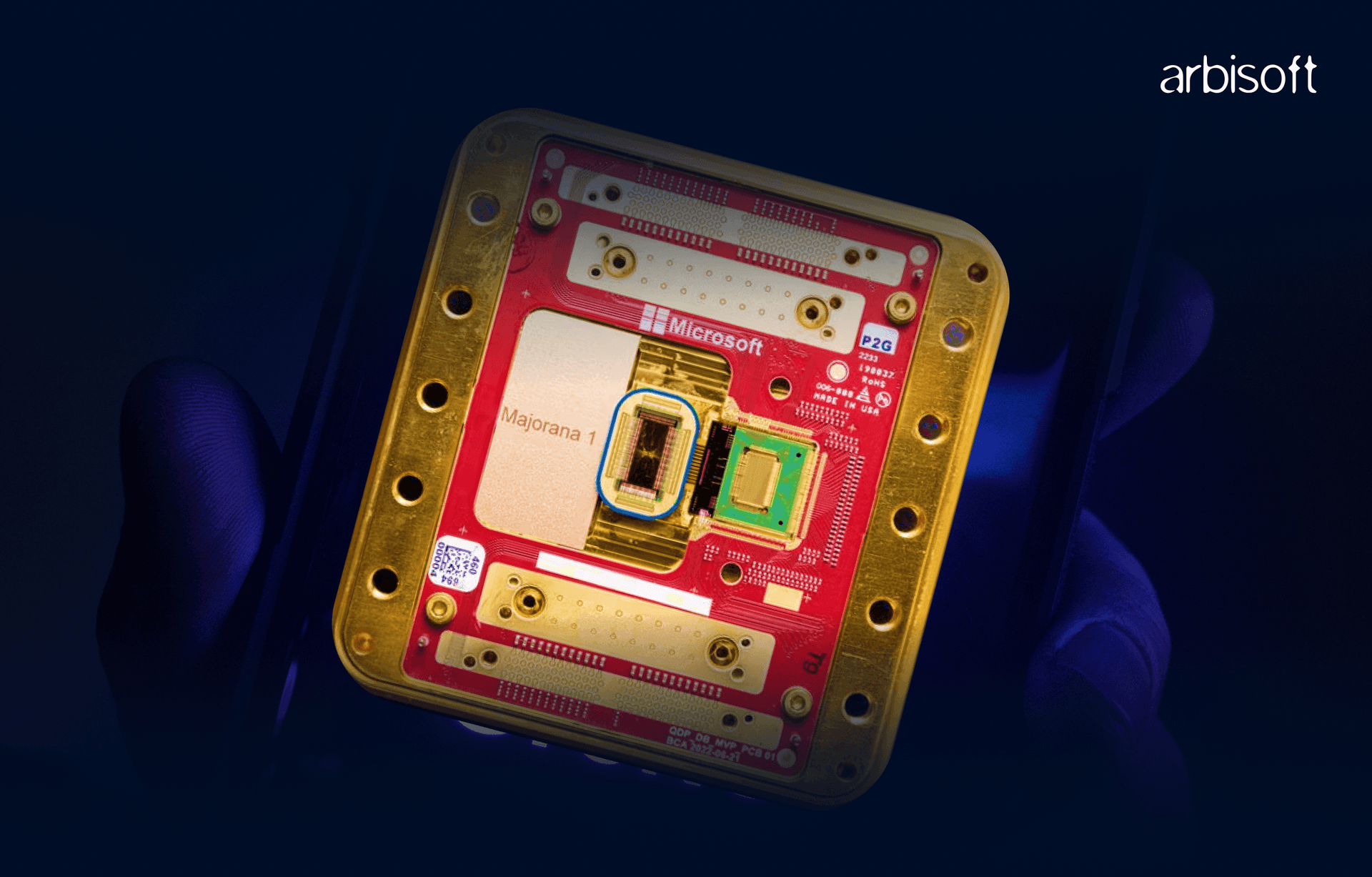We put excellence, value and quality above all - and it shows




A Technology Partnership That Goes Beyond Code

“Arbisoft has been my most trusted technology partner for now over 15 years. Arbisoft has very unique methods of recruiting and training, and the results demonstrate that. They have great teams, great positive attitudes and great communication.”
Microsoft’s Majorana 1 - A Quantum Leap or Just Hype?

Microsoft has just unveiled a quantum computing breakthrough that could change the dynamics of quantum computing forever. Meet Majorana 1 - a revolutionary quantum chip that gets us one step closer to quantum computing. Unlike traditional quantum systems, which often struggle with errors and scalability, Majorana 1 introduces a new approach that promises exceptional stability, efficiency, and power.
This isn’t just another lab experiment—it’s a critical step toward making quantum computing a practical tool for solving some of the world’s most complex problems. Majorana 1 could bring us closer to a future where quantum computers tackle challenges that are impossible for today’s machines.
Let’s dive into what makes Majorana 1 so groundbreaking and why it might just redefine the future of computing. For starters, let us talk about what is Microsoft Majorana 1.
What’s the Big Deal?
Quantum computers are like supercharged versions of regular computers. Instead of regular “bits” (which can be 0 or 1), they use “qubits” that can be both 0 and 1 at the same time. This lets them tackle problems way beyond today’s computers—like curing diseases, breaking down microplastics, or designing unbreakable encryption.
There's only one problem - qubits are super fragile. Even a tiny disturbance (like heat or noise) can crash them. Most quantum chips today need thousands of qubits just to fix these errors. Microsoft claims their Majorana 1 chip sidesteps this issue with a new approach - exotic particles and a new state of matter.
“We took a step back and said ‘OK, let’s invent the transistor for the quantum age. What properties does it need to have?” said Chetan Nayak, Microsoft technical partner. “And that’s really how we got here — it’s the particular combination, the quality, and the important details in our new materials stack that have enabled a new kind of qubit and ultimately our entire architecture.”
"Most of us grew up learning there are three main types of matter that matter: solid, liquid, and gas. Today, that changed," - CEO Satya Nadella said.
With this new chip, Microsoft claims to have created a new state of matter - solid, liquid, gas, plasma, and now the new topoconductor, or topological superconductor. But if this turns out to be a success, it could be a big breakthrough.
Inside Majorana
Majorana particles are named after Italian physicist Ettore Majorana, who first theorized their existence in 1937. Unlike electrons or protons, these particles don’t exist naturally. They only emerge under very specific conditions, like those created in Microsoft’s topological superconductor.
Here’s how it works:
- The chip uses nanoscopic wires made of the aluminum-indium arsenide combination.
- At extremely low temperatures, Majorana particles form at the ends of these wires.
- These particles act as qubits, storing information in a way that’s resistant to external noise.
- By “braiding” these particles (a process that involves swapping their positions), Microsoft can perform quantum operations with minimal errors.
Microsoft’s approach is a bold departure from the status quo. While competitors like IBM and Google are focused on increasing the number of qubits, Microsoft is prioritizing quality and stability. This could give them a significant edge as quantum systems scale up, pointing toward the future of LLMs and quantum technologies alike.
For example, in traditional quantum systems, hundreds or even thousands of physical qubits are needed to create a single logical qubit (a qubit stable enough for reliable computation). With Majorana 1, Microsoft hopes to drastically reduce this overhead, making quantum computing more efficient and practical.

Here Microsoft demonstrates how it gradually scales up one qubit to a larger system that can fix errors and make quantum computing more practical.
The Race for Quantum Dominance
Microsoft isn’t alone. The quantum race is heating up. Unlike IBM and Google, which focus on increasing qubit count, Microsoft prioritizes qubit quality and stability.
- Google’s Willow chip (105 qubits) claims to outperform classical computers by astronomical margins.
- IBM’s Condor chip (1,121 qubits) pushes the boundaries of raw processing power.
- China is investing $15.3 billion in quantum research to gain an edge.
Microsoft, however, argues that more qubits alone won’t solve the stability problem. If its Majorana-based qubits prove effective, they could offer a fundamentally better path to scalable quantum computing.
But… Is This Real?
Microsoft’s Majorana 1 chip has created a lot of hype, but not everyone is ready to accept it as a game-changer just yet. Some experts have doubts, and there are still challenges to account for.
1. Not Proven Yet
Microsoft’s research, published in Nature, is a big step forward. But it doesn’t fully prove that the qubits in Majorana 1 are truly based on topological superconductors. The results so far are promising, but not conclusive.
Some scientists are skeptical. For instance, physicist Vincent Mourik, who has criticized Microsoft’s past work in this area, believes their approach might not be the right one. Until Microsoft can scale up its system and show real-world results, many experts are staying cautious.
2. Controversy
This isn’t the first time Microsoft has claimed a big quantum breakthrough. Back in 2021, a similar study funded by the company had to be retracted. Researchers were found to have cherry-picked data to support their claims. Because of that, some scientists are now skeptical about Microsoft’s latest announcement.
Microsoft says this time the research is solid and has been peer-reviewed. But past mistakes still linger. Critics believe the company needs to be more open and make sure others can reproduce their results to fully earn back trust.
3. Investor Enthusiasm vs. Reality
Despite the skepticism, investors are bullish on quantum computing. Following Microsoft’s announcement, quantum computing stocks saw a noticeable bump:
- D-Wave ($QBTS): Up 13%
- Quantum Computing ($QUBT): Up 1.6%
- Rigetti ($RGTI): Up 4%
The quantum computing ETF (QTUM) also opened 1% higher the day after the news broke. This enthusiasm reflects the growing belief that quantum computing, while still in its early stages, has the potential to disrupt industries ranging from healthcare to finance.
But not everyone is convinced just yet. Some experts say it’s too early to celebrate. Quantum computing is a tricky field with big risks and big rewards. No one knows for sure which approach will win—Microsoft’s focus on stability or competitors’ push for more qubits.
In The End
Majorana 1 is promising but unproven. The technology has huge potential, but it’s still experimental. There are real questions about whether it can actually scale and work as promised. Microsoft’s approach is unique, but it’s just one of many. It’s too soon to say if Majorana 1 will change everything or just be another step forward.
One thing is certain—the world is paying attention. If Microsoft delivers, it could be something big. But for now, the big question remains - Is this a real deal or just more quantum hype?
























